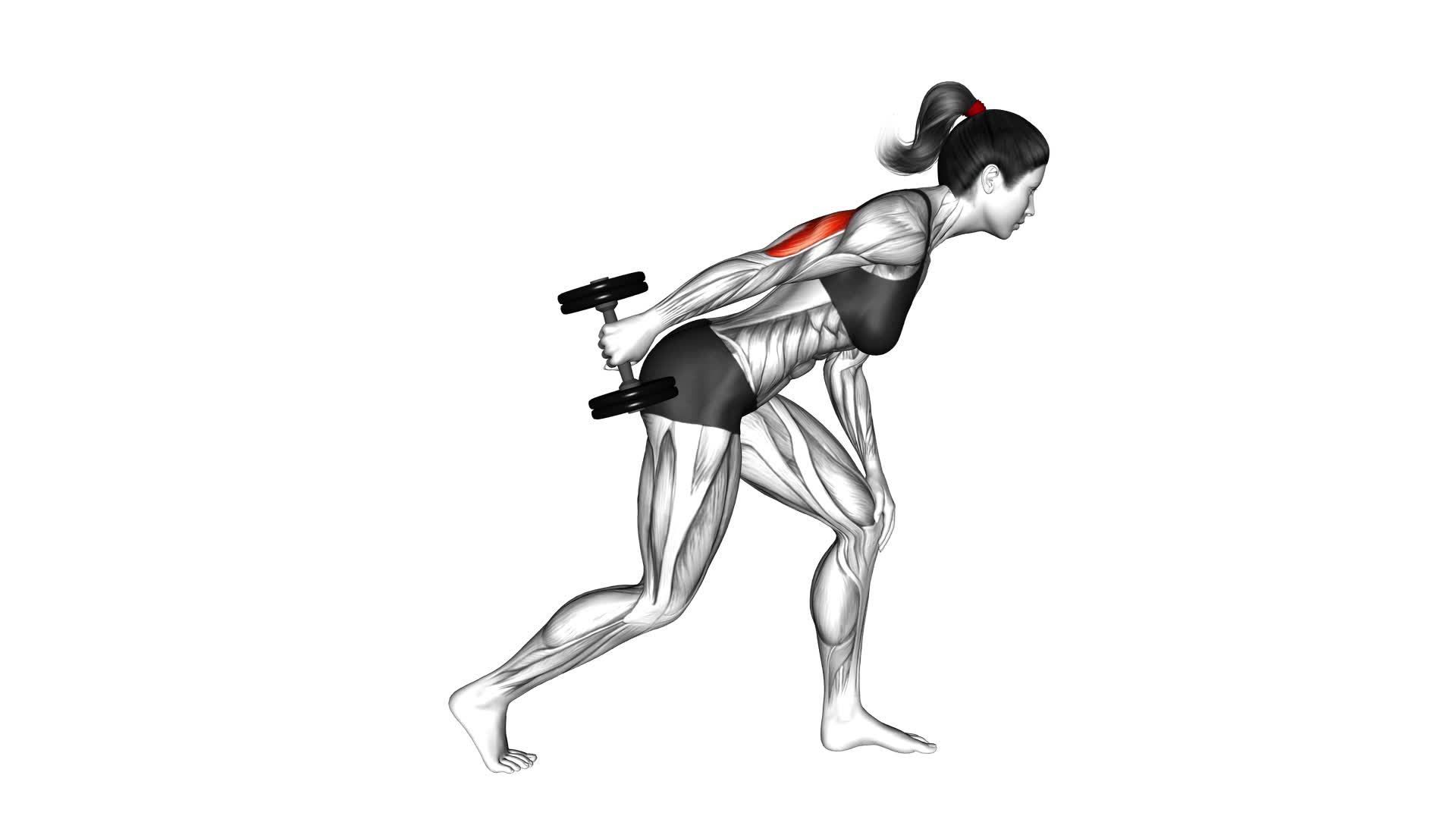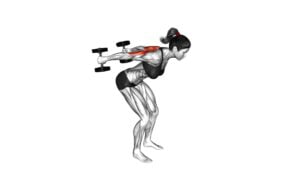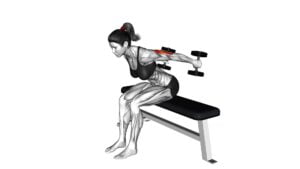Dumbbell One Arm Kickback (female) – Video Exercise Guide & Tips

Are you looking for a great exercise to tone and strengthen your arms? Look no further than the dumbbell one arm kickback!
Watch This Exercise Video
This video exercise guide and tips will show you how to perform this exercise with proper form and alignment.
Learn how to select the right dumbbell weight and avoid common mistakes.
Plus, we'll share a variation using a resistance band.
Get ready to maximize the effectiveness of your workouts with this targeted arm exercise.
Key Takeaways
- Proper form and alignment are essential for performing the dumbbell one arm kickback exercise effectively.
- Selecting the right dumbbell weight is important to ensure proper form and avoid injury.
- Progression over time is crucial for continued muscle growth and strength gains.
- It is important to take precautions to avoid injury risks, such as starting with lighter weights and maintaining proper form throughout the exercise.
Proper Form: Positioning and Alignment
To achieve proper form and alignment during the dumbbell one arm kickback exercise, start by positioning yourself in a stable standing position with your feet shoulder-width apart. This positioning is crucial to ensure stability and prevent any unnecessary strain on your muscles or joints. Keep your back straight and engage your core muscles to maintain a neutral spine throughout the exercise. Bend your knees slightly to provide a solid foundation for your body.
When performing the dumbbell one arm kickback, it's essential to focus on proper alignment techniques. Begin by holding the dumbbell in your right hand, with your palm facing your body. Extend your right arm straight behind you, parallel to the floor, while keeping your elbow close to your body. Make sure to avoid any swinging or jerking motions during the movement, as this can compromise your form and reduce the effectiveness of the exercise.
Transitioning into the subsequent section about selecting the right dumbbell weight, it's important to consider your current strength and fitness level. Choosing a dumbbell that's too heavy may lead to improper form and increased risk of injury. On the other hand, selecting a weight that's too light may not provide enough resistance to challenge your muscles. Finding the right balance is key to maximizing the benefits of the dumbbell one arm kickback exercise.
Selecting the Right Dumbbell Weight
When selecting the right dumbbell weight, there are a few important points to consider.
First, as a beginner, it's important to start with a weight that challenges you but allows for proper form and technique.
Secondly, as you progress in your training, you can gradually increase the weight to continue challenging your muscles.
Lastly, it's crucial to avoid selecting a weight that's too heavy, as this can increase the risk of injury.
Weight for Beginners
Start with a lightweight dumbbell to ensure proper form and prevent injury. As a beginner, it's important to select the right weight that challenges you without overwhelming your muscles.
Here are some guidelines to help you choose the appropriate dumbbell weight:
- Consider your current strength level and fitness goals.
- Start with a weight that allows you to complete 8-12 repetitions with proper form.
- Gradually increase the weight as you become stronger and more comfortable.
- Listen to your body and avoid using a weight that causes pain or compromises your technique.
- If you're struggling with a particular exercise, modify it by using lighter weights or performing alternative exercises that target the same muscle group.
Progression Over Time
As you continue your fitness journey, it's important to progressively select the right dumbbell weight to ensure ongoing growth and prevent plateaus. To achieve this, you can utilize various progression techniques and track your progress.
One effective technique is the concept of progressive overload, where you gradually increase the weight over time. Start with a weight that challenges you but allows you to maintain proper form. As you become stronger and more comfortable, gradually increase the weight to continue challenging your muscles.
Another technique is to focus on increasing the number of repetitions or sets you perform with a particular weight before moving up to a heavier dumbbell. By tracking your progress, you can ensure that you're consistently challenging yourself and making progress towards your fitness goals.
Avoiding Injury Risks
To avoid injury risks, select the appropriate dumbbell weight for your workout by assessing your strength and choosing a weight that challenges you without compromising your form. Here are some tips to help you prevent injuries during your dumbbell one-arm kickback:
- Start with a lighter weight and gradually increase the weight as you get stronger.
- Ensure that you can maintain proper form throughout the exercise.
- Warm up your muscles before beginning the exercise to reduce the risk of injury.
- Listen to your body and stop if you experience any pain or discomfort.
- Consult with a fitness professional if you're unsure about the appropriate weight for your fitness level.
By following these injury prevention tips, you can safely and effectively perform the dumbbell one-arm kickback exercise.
Now, let's move on to the step-by-step execution of the exercise.
Step-by-Step Execution of the Dumbbell One Arm Kickback
To execute the dumbbell one arm kickback correctly, there are a few key points to keep in mind.
First, maintain a stable stance with your feet shoulder-width apart.
Second, keep your back straight and core engaged throughout the movement.
Finally, focus on extending your arm fully behind you while squeezing your triceps.
Proper Form Tips
You can achieve proper form for the Dumbbell One Arm Kickback by keeping your elbow close to your side and extending your arm backwards. This exercise is highly effective for targeting and toning your triceps.
Here are some important tips to ensure proper form and maximize the benefits while minimizing the risk of injury:
- Stand with your feet shoulder-width apart and hold a dumbbell in one hand.
- Keep your back straight and core engaged throughout the movement.
- Bend your knees slightly and hinge forward at the hips.
- Place your opposite hand on a stable surface for support.
- Slowly extend your arm straight back, squeezing your tricep at the top of the movement.
Common Mistakes to Avoid
One common mistake to avoid when performing the Dumbbell One Arm Kickback is allowing your elbow to stray from your side. This is a crucial error that can compromise the effectiveness of the exercise and increase the risk of injury. To prevent this, make sure to keep your elbow close to your body throughout the movement.
This will ensure that you're properly targeting your triceps and avoiding unnecessary strain on your shoulder joint. Another common mistake is using too much weight. It's important to choose a weight that allows you to maintain proper form and control throughout the exercise.
Using excessive weight can lead to improper technique and put you at risk of injury. Remember, the goal is to perform the exercise with precision and focus on the targeted muscle group, not to lift the heaviest weight possible.
Benefits of This Exercise
Performing the Dumbbell One Arm Kickback exercise offers several benefits for improving tricep strength and toning your arms. Here are the benefits of this exercise:
- Muscle Activation: The Dumbbell One Arm Kickback specifically targets the tricep muscles, which are responsible for arm extension. This exercise activates and isolates the tricep muscles, maximizing results and promoting muscle growth.
- Increased Strength: By regularly incorporating the Dumbbell One Arm Kickback into your workout routine, you can gradually increase the weight and resistance, leading to improved tricep strength over time.
- Toned Arms: This exercise helps to tone and define the triceps, giving your arms a more sculpted and lean appearance.
- Functional Movement: The Dumbbell One Arm Kickback mimics the motion of pushing or extending your arm, which is a common movement in daily activities. By strengthening your triceps, you can enhance your overall arm strength and functionality.
- Balance and Stability: This exercise challenges your balance and stability as you perform it unilaterally, using only one arm at a time. This can help improve your overall balance and stability in everyday movements.
Common Mistakes to Avoid
To avoid common mistakes during the dumbbell one arm kickback exercise, make sure to maintain proper form and avoid any swinging or jerking movements. These mistakes can't only hinder your progress but also increase the risk of injury.
One common mistake is using too much weight. It's important to choose a weight that allows you to perform the exercise with control and without compromising your form.
Another mistake to avoid is arching your back. This can put unnecessary strain on your lower back and increase the risk of injury. Instead, keep your back straight and engage your core muscles to stabilize your body throughout the movement.
Additionally, make sure to fully extend your arm behind you during the kickback motion. Partially extending the arm can limit the effectiveness of the exercise and increase the chance of muscle imbalances.
Lastly, avoid rushing through the exercise. Perform each repetition slowly and with control, focusing on squeezing your tricep at the top of the movement.
Variation: Dumbbell One Arm Kickback With Resistance Band
To add variety and challenge to your dumbbell one arm kickback exercise, you can try the variation of using a resistance band. This variation is great for advanced users who want to take their workout to the next level.
Here are some resistance band alternatives and variations that you can incorporate into your routine:
- Single Arm Kickback with Resistance Band: Attach the resistance band to a sturdy anchor point and hold the other end of the band with one hand. Perform the kickback motion while keeping tension on the band throughout the movement.
- Double Arm Kickback with Resistance Band: Attach the resistance band to a sturdy anchor point and hold the other end of the band with both hands. Perform the kickback motion simultaneously with both arms, keeping tension on the band at all times.
- Resistance Band Kickback with Lunge: Perform a lunge while holding the resistance band with one hand. As you come up from the lunge, perform the kickback motion with the same arm.
- Resistance Band Kickback with Squat: Perform a squat while holding the resistance band with one hand. As you come up from the squat, perform the kickback motion with the same arm.
- Resistance Band Kickback with Bicep Curl: Perform a bicep curl while holding the resistance band with one hand. As you lower the dumbbell, perform the kickback motion with the same arm.
Incorporating these resistance band alternatives and variations into your workout routine can help target different muscle groups and add variety to your training.
Tips for Maximizing the Effectiveness of the Dumbbell One Arm Kickback
To maximize the effectiveness of the dumbbell one arm kickback, focus on maintaining proper form and engaging your triceps throughout the movement. This exercise primarily targets the triceps, so it's important to perform it correctly to maximize results. Here are some tips to help you get the most out of your dumbbell one arm kickbacks:
- Start with an appropriate weight: Choose a weight that challenges your muscles without compromising your form. It should be heavy enough to feel challenging, but not so heavy that you sacrifice proper technique.
- Maintain proper form: Stand with your feet shoulder-width apart and hinge forward at the hips, keeping your back straight. Keep your upper arm parallel to the ground and extend your forearm back, fully extending your elbow. Avoid swinging or using momentum to lift the weight.
- Focus on the triceps: Throughout the movement, concentrate on contracting your triceps. Imagine that you're pushing the weight behind you using only your triceps. This will help you engage the muscle effectively and get the most out of each rep.
- Try alternative exercises: If you want to mix up your triceps workout, consider incorporating alternative exercises such as tricep pushdowns, overhead tricep extensions, or close grip bench presses. These exercises target the triceps from different angles and can help to further enhance your results.
Frequently Asked Questions
How Many Sets and Reps Should I Do for the Dumbbell One Arm Kickback Exercise?
When it comes to the dumbbell one arm kickback exercise, it's important to know how many sets and reps to do. To perform this exercise correctly, start by holding a dumbbell in one hand and keeping your back straight.
Extend your arm straight back, squeezing your triceps.
As for sets and reps, it's recommended to start with 3 sets of 10-12 reps on each arm. This will help build strength and tone your triceps effectively.
Avoid using too much weight or swinging your body for better results.
Can I Perform the Dumbbell One Arm Kickback Exercise With Both Arms at the Same Time?
Yes, you can perform the dumbbell one arm kickback exercise with both arms at the same time. This variation is called the double arm kickback. It allows you to target both triceps simultaneously, increasing the overall intensity of the exercise.
The benefits of the dumbbell kickback exercise include strengthening and toning your triceps, improving arm definition, and enhancing upper body strength. Incorporating dumbbell kickback variations into your workout routine can help you achieve your fitness goals faster.
Can I Substitute the Dumbbell With a Kettlebell for the Dumbbell One Arm Kickback Exercise?
Yes, you can substitute the dumbbell with a kettlebell for the dumbbell one arm kickback exercise. This variation of the exercise can provide a different range of motion and challenge your muscles in a new way.
Make sure to choose a kettlebell that's suitable for your strength level and properly perform the exercise with proper form and control.
Consult with a fitness professional if you're unsure about the correct technique.
Is It Necessary to Warm up Before Performing the Dumbbell One Arm Kickback Exercise?
Before performing the dumbbell one arm kickback exercise, it's necessary to warm up. Warming up before exercise has many benefits, such as increasing blood flow to the muscles and improving flexibility. It also helps to prevent injury and prepare your body for the workout ahead.
When performing the dumbbell one arm kickback exercise, common mistakes to avoid include using too much weight, swinging the arm, and not maintaining proper form.
How Often Should I Incorporate the Dumbbell One Arm Kickback Exercise Into My Workout Routine for Best Results?
To get the best results from the dumbbell one arm kickback exercise, it's important to incorporate it into your workout routine regularly. Start by adding it to your routine two to three times a week.
Aim for 3 sets of 10-12 reps per arm, using a weight that challenges you but allows you to maintain proper form. As you progress, you can increase the weight or the number of sets to continue challenging your muscles.
Conclusion
In conclusion, the dumbbell one arm kickback is a great exercise for targeting and toning the triceps. By maintaining proper form and selecting the appropriate dumbbell weight, you can effectively work this muscle group.
Remember to avoid common mistakes and consider incorporating variations, such as using a resistance band, for added challenge.
By following these tips, you can maximize the effectiveness of this exercise and achieve your fitness goals.

Author
Years ago, the spark of my life’s passion ignited in my mind the moment I stepped into the local gym for the first time. The inaugural bead of perspiration, the initial endeavor, the very first surge of endorphins, and a sense of pride that washed over me post-workout marked the beginning of my deep-seated interest in strength sports, fitness, and sports nutrition. This very curiosity blossomed rapidly into a profound fascination, propelling me to earn a Master’s degree in Physical Education from the Academy of Physical Education in Krakow, followed by a Sports Manager diploma from the Jagiellonian University. My journey of growth led me to gain more specialized qualifications, such as being a certified personal trainer with a focus on sports dietetics, a lifeguard, and an instructor for wellness and corrective gymnastics. Theoretical knowledge paired seamlessly with practical experience, reinforcing my belief that the transformation of individuals under my guidance was also a reflection of my personal growth. This belief holds true even today. Each day, I strive to push the boundaries and explore new realms. These realms gently elevate me to greater heights. The unique combination of passion for my field and the continuous quest for growth fuels my drive to break new ground.







